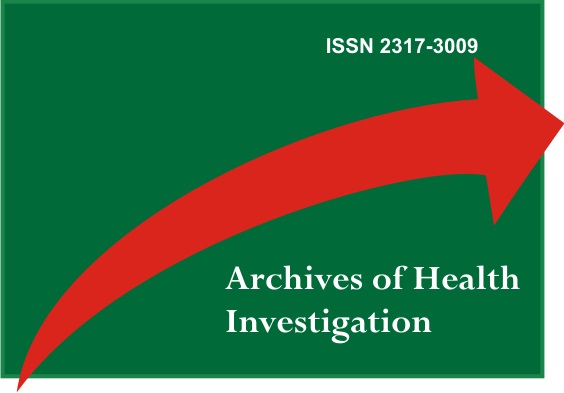Synchronous cystic lesions in the jaws: case reports
DOI:
https://doi.org/10.21270/archi.v10i8.5306Keywords:
Odontogenic Keratocyst, Ameloblastoma, Nasopalatine Duct CystAbstract
The association of odontogenetic lesions affecting the maxillary bones in the same patient is rare. The aim of this paper is to report two cases of synchronous lesions affecting the same patient. In the first case, the patient presented an odontogenic keratocyst in the jaw and a nasopalatine duct cyst, and in the second case, the patient presented an ameloblastoma in the jaw and nasopalatine duct cyst. Both cases were treated through the total removal of the lesions, microscopically revealed the respective diagnoses and now they are being controlled, with absence of recurrence after four years.
Downloads
References
Shear M. Cistos da Região Bucomaxilofacial - Diagnóstico e Tratamento. 3.ed. São Paulo: Santos, 1999.
Shylaja S, Balaji K, Krishna A. Nasopalatine duct cyst: report of a case with review of literature. Indian J Otolaryngol Head Neck Surg. 2013;65(4):385-8.
Martins MD, Russo MP, Bussadori SK, Fernandes KPS, Missawa GTM, Martins MAT. Nasopalatine duct cyst: report of case and literature review. Rev Inst Ciênc Saúde. 2007;25(2):193-7.
Suter VG, Sendi P, Reichart PA, Bornstein MM. The nasopalatine duct cyst: an analysis of the relation between clinical symptoms, cyst dimensions, and involvement of neighboring anatomical structures using cone beam computed tomography. J Oral Maxillofac Surg. 2011;69(10):2595-603
Philipsen HP. OM keratocystedr (Kolesteratomer) e kaeberne. Tandlaegebladet. 1956;60:963-71.
Pindborg J, Hansen J. Studies on odontogenic cyst epithelium. II. Clinical and roentgenographic aspects of odontogenic keratocysts. Acta Pathol Microbiol Scand. 1963;58:283.
Barnes L, Eveson JW, Reichart P, Sidransky D. World Health Organization Classification of Head and Neck Tumours. Pathology and Genetics of Head and Neck Tumours. 3rd ed. Lyon: IARC Press; 2005. p 160-1, 206-7.
Wright JM, Vered M. Update from the 4th Edition of the World Health Organization Classification of Head and Neck Tumours: Odontogenic and Maxillofacial Bone Tumors. Head Neck Pathol. 2017;11(1):68-77.
Menon S. Keratocystic Odontogenic Tumours: Etiology, Pathogenesis and Treatment Revisited. J Maxillofac Oral Surg. 2015;14(3):541-7.
Stoelinga PJW. The treatment of odontogenic keratocysts by excision of the overlying, attached mucosa, enucleation, and treatment of the bony defect with Carnoy solution. J Oral Maxillofac Surg. 2005;63:1662-6.
Carlson ER, Oreadi D, McCoy JM. Nevoid Basal Cell Carcinoma Syndrome and the Keratocystic Odontogenic Tumor. J Oral Maxillofac Surg. 2015;73(12Suppl):S77-86.
Maurette PE, Jorge J, de Moraes M. Conservative treatment protocol of odontogenic keratocyst: a preliminary study. J Oral Maxillofac Surg. 2006;64(3):379-83.
Chrcanovic BR, Gomez RS. Recurrence probability for keratocystic odontogenic tumors: An analysis of 6427 cases. J Craniomaxillofac Surg. 2017;45(2):244-51.
Kim J, Nam E, Yoon S. Conservative management (marsupialization) of unicystic ameloblastoma: literature review and a case report Maxillofac Plast Reconstr Surg. 2017;39(1):38
Mesquita JA, Luna AHB, Nonaka CFW, Godoy GP, Alves PM. Aspectos clínico, tomográfico e histopatológicos do cisto do ducto nasopalatino. Braz j otorhinolaryngol. 2014;80(5):448-50.
Kinard BE, Chuang SK, August M, Dodson TB. For treatment of odontogenic keratocysts, is enucleation, when compared to decompression, a less complex management protocol? J Oral Maxillofac Surg. 2015;73(4):641-8.
Lau SL, Samman N. Recurrence related to treatment modalities of unicystic ameloblastoma: a systematic review. Int J Oral Maxillofac Surg. 2006;35:681-90.
Zhang J, Gu Z, Jiang L, Zhao J, Tian M, Zhou J et al. Ameloblastoma in children and adolescents. Br J Oral Maxillofac Surg. 2010;48(7):549-54.
de Paulo LFB, Oliveira MTF, Rodrigues ÁR, Zanetta-Barbosa D. Treatment of an extensive unicystic ameloblastoma in a 7-year-old child: the best approach? Br J Oral Maxillofac Surg. 2015;53(3):292-4.


